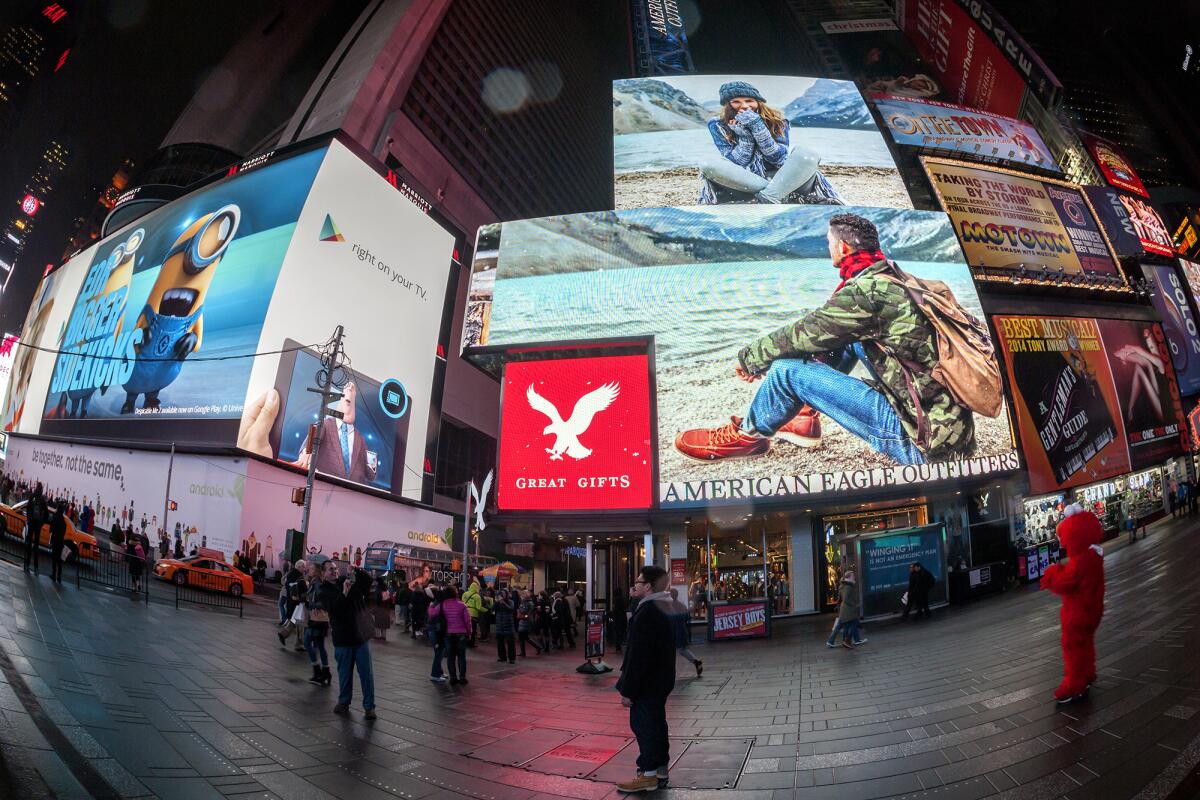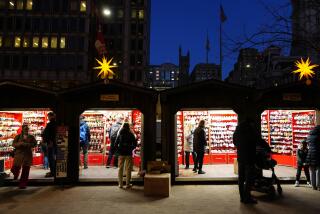American Eagle is thriving even as shopping malls shrivel

On a recent afternoon, college student Michele Jacobs walked into an American Eagle Outfitters store in Manhattan to buy some pieces from its Aerie lingerie line. She left with two bralettes — plus a jean skirt and a couple pairs of shorts.
“I feel like it’s really hard to not spend money when I go in there,” said Jacobs, 19, a rising sophomore at Franklin & Marshall College in Pennsylvania. “The majority of my clothing is from American Eagle. All my jeans are from here.”
In many ways, the success of American Eagle Outfitters Inc. doesn’t make sense. Most teen retailers have struggled to appeal to the newest crop of young shoppers while e-commerce sites have scattered the stores’ once-loyal customers. The situation has led Charlotte Russe and Aeropostale into bankruptcy and Abercrombie & Fitch Co. to close some flagships and shrink the footprint of its stores. Fast-fashion retailer Forever 21 Inc. is said to be exploring a debt restructuring to shore up its liquidity.
Yet American Eagle, which has been around for 42 years, has found solid footing. It’s consistently at or near the top of its peer group for revenue growth and digital sales. Teenage boys and girls continue to say it’s one of their favorite brands, according to Piper Jaffray’s semiannual survey. Investors will get a fresh look at how the company is doing Wednesday, when it reports quarterly earnings. The start of 2019 has not been kind to the U.S. apparel industry.
American Eagle’s stock has declined about 3% this year, and although the shares are underperforming the benchmark Standard & Poor’s 500 index, they are holding up better than most peers even amid renewed investor anxiety about the retail apparel industry in the United States. Abercrombie stock is down about 14%, Urban Outfitters Inc. shares have dived about 26%, and Guess Inc. shares have slid about 24%.
Jeans loyalty
American Eagle’s popularity is partly fueled by Aerie, as well as its denim business, a space in which the company has preserved its stature while others have faltered, said Oliver Chen, a retail analyst at Cowen. Jeans are well-priced and once consumers find the right fit, they’re pretty loyal to the brand, he said.
American Eagle jeans surpassed $1 billion in annual sales last year, said Chad Kessler, global brand president. And executives think there’s more for the taking. Chief Financial Officer Robert Madore said in March that Gap Inc.’s announcement that it would close hundreds of stores provides a “huge opportunity.”
“They’re working from a position of strength while others are not, and that’s helpful,” Chen said. “It’s not easy to adapt because teens want variety, so the new trend is no trend.”
The first American Eagle store opened in 1977 in a mall in Michigan. It wasn’t until 1990 that the company created its private-label products, which included men’s boot-cut and worker jeans. Signature denim came a few years later.
In a fashion world still dominated by athleisure, competition among retailers to put shoppers back in jeans is heating up. Levi Strauss & Co. and Kontoor Brands Inc. went public this year, and J. Crew Group Inc. may do the same for its denim line Madewell this year.
Jeans companies have made headway by churning out denim pants that are as comfortable as leggings. American Eagle has stayed ahead of the curve by using stretch technology, distressed treatments and a wide range of sizes, including lengths, Chen said. In some stores, customers can personalize their jeans by adding back patches or paint.
‘Playing it safe’
The retailer wasn’t always at the top of its game. Five years ago, American Eagle struggled to keep up with the pace of fast-fashion chains such as H&M and Forever 21. It announced plans in 2014 to close about 150 stores over three years, and its revenue and same-store sales declined for seven straight quarters.
“They were playing it safe to a degree,” said Gabriella Santaniello, founder of retail consulting firm A Line Partners. “But what we’re starting to see from them is that they’re really evolving their product.”
American Eagle is also trying in-store concepts to keep current fans as they mature. The Manhattan location where Jacobs shopped, which is close to New York University, has a study area and washing machines and dryers under pink neon signs where students can do laundry free of charge. The catch: They can’t leave during the wash and dry cycles, which means some visitors stay in the store longer.
American Eagle is gaining cachet as a lingerie and swimsuit seller through Aerie, which it launched nationwide in 2006. Aerie has posted quarterly same-store sales growth in the double digits for a handful of years — often 20% or higher — consistently outpacing the American Eagle brand.
‘Game changer’
Aerie also helps spread the company’s diversity message. It has aimed to be more inclusive of women of different shapes, sizes and backgrounds, a departure from the images traditionally promoted by rivals including Victoria’s Secret. Executives decided some years ago to not retouch photos of models in Aerie campaigns.
Emily Zabaleta, a 25-year-old digital designer, said she and her friends started buying Aerie because of plus-size model Iskra Lawrence, who is often featured in its advertising.
“Aerie is an absolute game changer,” said Zabaleta, who recently placed an online rush order for clothes to take on a cruise. “A lot of the times when I’m looking at these brands it’s, ‘Oh, how am I able to make myself look like that?’ as opposed to ‘Oh, I look like that and that could look good on me.’ ”
Young voices
This spring, American Eagle began identifying young people — of different races, gender identities and body sizes — who are passionate about activism and have sizable social media followings. The company asked them to style themselves in American Eagle clothes and take their own photos, some of which now adorn walls of stores across the country.
The campaign resonated with customers, about half of whom belong to Gen Z, the generation of people roughly between the ages of 7 and 22.
The connection with young shoppers has also influenced the company’s leadership. Last year, when some survivors of the high school shooting in Parkland, Fla., appeared on the cover of Time magazine wearing American Eagle jeans, executives were so moved that they wanted to find a way to support the voices of more teenagers and young adults, Kessler, the brand president, said in an interview.
This spring, the retailer launched its AExME council with a group of young adults. They are paired with mentors and gather about once a month to discuss practices and products. At a meeting at the company’s Pittsburgh headquarters this year, they made suggestions for the back-to-school collection, which the company plans to act on, Kessler said.
“It’s important for kids in this generation to know not all big companies are the same,” he said. “We are turning over a certain amount of control of the brand to this generation.”






